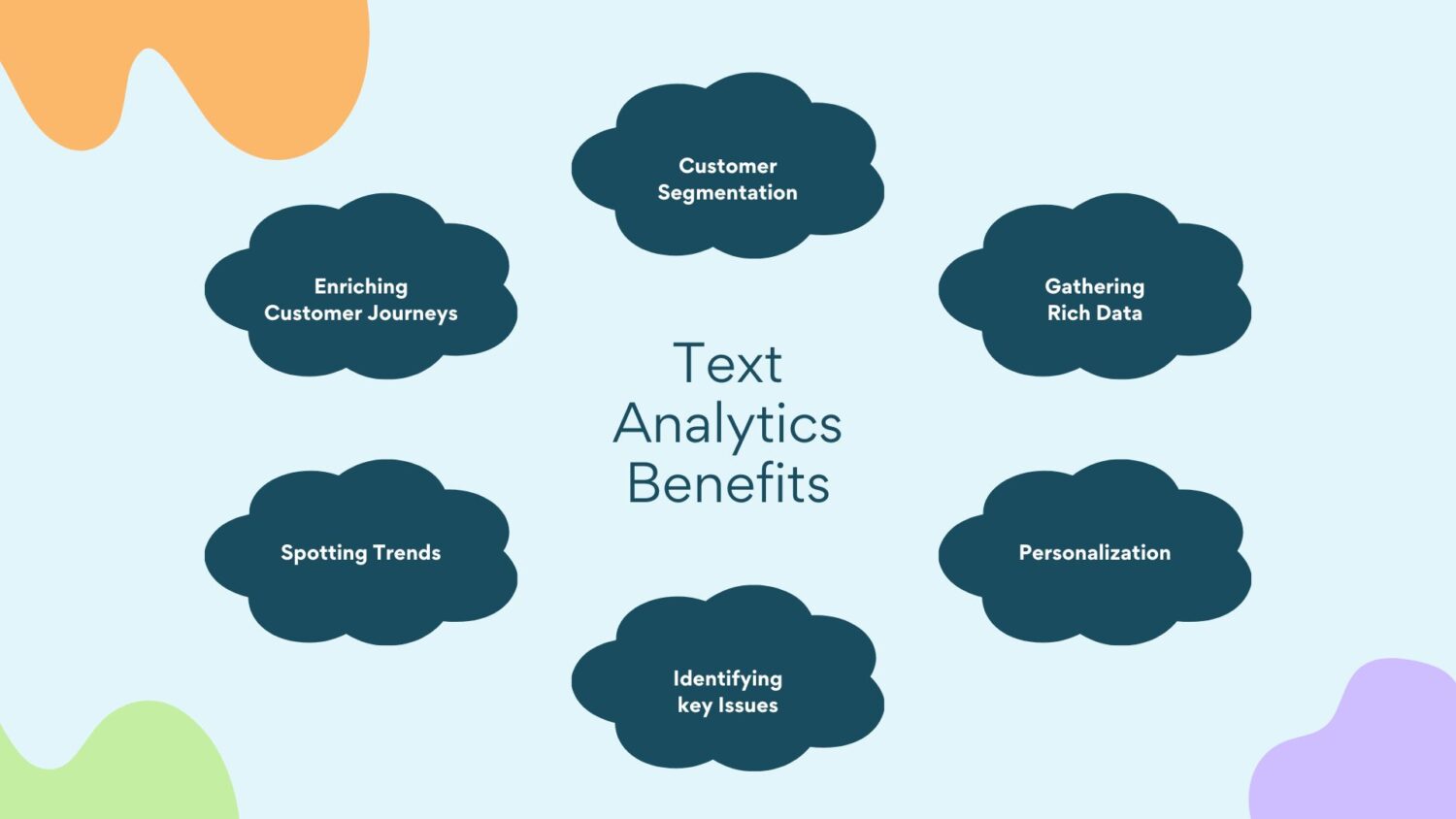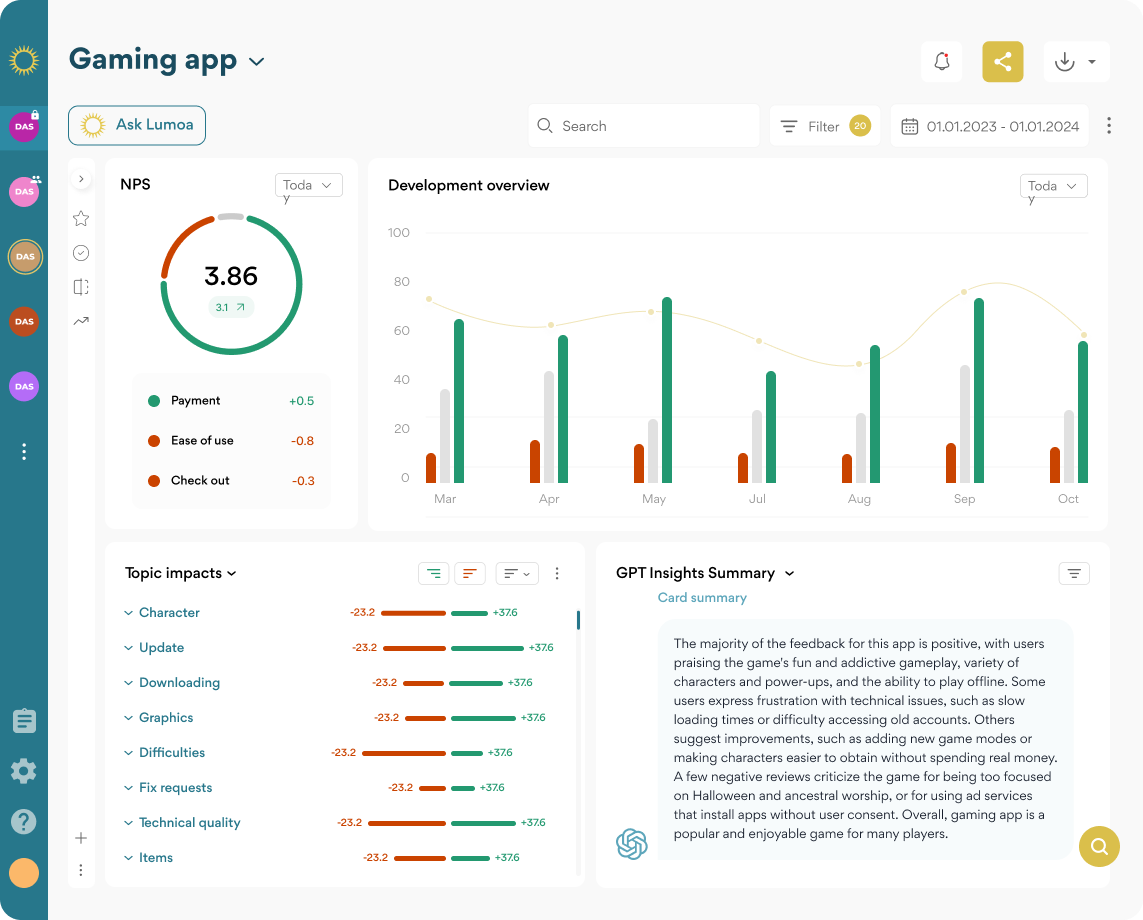Text Analytics in Customer Feedback: The CXO’s Secret Weapon

Last updated on July 9, 2024
Have you ever traveled to a country where you didn’t speak the language? If you have, you must know how exhausting it can be to get help with the simplest of requests. I remember spending over 40 minutes trying to get change for a €20 bill in Paris until a kind stranger finally understood what I was asking for.
After that frustrating experience, I had a newfound appreciation for customers who have to deal with unresponsive customer experience (CX) teams that fail to act on customer feedback!
Just like a hapless tourist, customers are eager to share details of their experience. CX professionals know they can share it as constructive feedback (if you’re lucky) or harsh criticism (if you aren’t).
Whatever shape the feedback takes, it contains valuable information that can be used to improve your business’ performance. However, first, you have to know where to look!
That’s where text analytics in customer feedback proves to be one of the most valuable tools for any business. If you want to satisfy—or dare I say, delight—your customers, you need to understand their wants and needs. That will give you a clear goal to work toward and guide your organization’s decision-making processes.
In This Article:
The Role of a CXO in Leveraging Text Analytics
All businesses share one common goal, no matter how different they are in terms of scale or industry: Customer satisfaction.
Customer satisfaction drives key metrics like your Net Promoter Score (NPS). Satisfied customers are also paying customers, so keeping them happy also helps your bottom line. In 2024, delivering quality CX is so critical to business success that no Customer Experience Officer (CXO) can afford to overlook it. In fact, a report from 2020 found 95% of senior marketing executives agreed that CX roles were essential for business growth.
As the CXO, your world revolves around understanding and enhancing the customer experience. You have to dig deep into your customers’ minds to understand their behavior. And if you want to become a real change-maker in your organization, you need to learn how to extract insights from customer feedback.
When to use text analytics
This situation is where automated text analytics in customer feedback is brought in: it can help in sorting out the key topics talked about and reveal the general sentiment per topic.

If there’s a lot of data, the categorization can be a very detailed one: instead of personnel, the categories can separate customer support personnel from sales personnel or divide the feedback about personnel into comments about their behavior, knowledgeability, responsiveness, etc.
Careful and well-implemented text analytics can easily reveal dozens of improvement ideas. Based on the customer experience analytics you would know that people talk negatively about your customer service response times, the information available on your website, the behavior of your agents, the features of your latest product release, etc.
Transforming Analytics into Action
Remember that the true value of text analytics in customer feedback can only be realized when it impacts decision-making and actions within a company. Thus, basic text analytics is just the first step toward transforming data into value:

-
A better, more insightful text analytics tool to understand the most relevant drivers of customer experience improvement. Results must be meaningful from a business perspective and reveal areas for improvement.
-
Making informed decisions that consider both the impact of proposed actions on the customer experience as well as the cost and benefit of the proposed measures.
-
An organization that can act on feedback.
-
Most importantly, the company needs to improve in various areas.
A CXO’s Perspective on Text Analytics in Customer Feedback
Customer experience (CX) operations aren’t left to any one department. Every employee, from the product designer to the in-store salesperson, all the way to the after-sales customer service rep, has a role to play. Essentially, CX is intertwined with every aspect of a business. When one improves, the positivity rubs off on the other.
For a Customer Experience Officer (CXO), dedicating resources to analyzing text feedback from customers can have several benefits:

- Dissecting Customer Segments: Text analytics in customer feedback allows you to delve into the nuances of different customer groups, understanding their unique preferences and expectations.
- Harvesting Rich Data: With this tool, you get more than just numbers; you get stories. Large volumes of qualitative data turn into actionable insights.
- Enriching the Customer Journey: Every piece of feedback is an opportunity to refine the customer journey, making each interaction more meaningful and satisfying.
- Pattern Recognition: Spotting trends in customer behavior becomes easier, helping you anticipate needs and tailor experiences.
- Personalization at Scale: This technology enables you to treat each customer as an individual, offering personalized experiences that resonate and build loyalty.
- Problem-Solving: Identifying and addressing issues within the customer journey becomes more efficient, ensuring a seamless experience for every customer.
Mastering the basics of text analytics gives CXOs more context and information, which they can then use to drive data-driven decision-making and process optimization for the business.
Strategies for CXOs to Implement Text Analytics in Customer Feedback
Ultimately, the CXO has to use customer feedback to better the business. That means they need to be able to pick out potentially valuable information from a vast pile of data as if they were picking a needle out of a haystack.
You’re likely to encounter all sorts of data when going through customer feedback: Quantitative and qualitative, structured and unstructured, and most importantly, insightful and non-insightful.
Your role involves discerning which data points can be transformed into actions that enrich the customer experience and drive business value.
Here are some CX strategies to refine your ability to spot and utilize valuable data through text analytics:
- Amplify the Voice of the Customer (VoC): Place a stronger emphasis on understanding and responding to the VoC. This means not just listening but also interpreting and acting on what customers are communicating.
- Action-Oriented Data Discovery: Seek out meaningful data that can lead to concrete actions, enhancing customer satisfaction and loyalty.
- Engagement Through Feedback Surveys: Implement feedback and feature request surveys. This direct line of communication allows customers to express their needs and desires, providing a rich source of data for analysis.
- Social Media Insights: Keep an eye on social media channels for both positive and negative mentions. This real-time feedback is a goldmine for understanding public perception and immediate customer sentiments.
- Entity Analysis: Identify related entities such as competing brands, different product models, or packaging materials mentioned in customer feedback. Understanding these relationships can provide insights into customer preferences and market trends.
- Metric-Driven Improvement: Regularly measure and track key metrics like Net Promoter Score (NPS) and Customer Satisfaction (CSAT). Use these metrics to gauge the effectiveness of your CX strategies and guide continuous improvement.
Does that sound like a lot to handle, especially for someone with a CXO’s busy schedule? Well, thankfully, software from Lumoa simplifies every aspect of customer experience and feedback analysis.

This AI-powered CX tool can truly do it all: Gathering customer feedback no matter the source, processing it, and preparing reports based on the processed data.
Lumoa gives CXOs a detailed look at the inner workings of their company’s CX, letting them make informed, data-driven decisions.
Lumoa’s software is also enhanced with cutting-edge technology.
Along with its perfect record-keeping and feedback-gathering features, this platform also boasts generative artificial intelligence (AI), machine learning (ML), and natural language processing (NLP) capabilities, allowing it to prepare smart, actionable customer feedback reports for CXOs to act on.
Challenges in Standard Text Analytics Practices
Clearly, text analytics is a powerful tool that can transform customer feedback data into action plans that benefit the business. But nothing good comes easy. If you want to enjoy the benefits of customer feedback analytics, you need to prepare for the challenges that come with text analysis.
Semantic Confusion
Traditionally, text analysis has always been more challenging to execute than numerical analysis. Numbers have fixed values, but the meaning of words changes depending on the context. For example, the word “star” could either mean a heavenly body or a major celebrity, based on whether you’re reading a scientific journal or a tabloid.
Since text is more open to interpretation, organizing it into reliable data comes with its own set of challenges.
Noise in the data
Smartphones are truly amazing devices. More people are using their phones to access the internet than ever before. In 2024, over 55% of web traffic is from mobile devices.
But for all the advanced features manufacturers pack into phones, the touchscreen keyboard refuses to be tamed. Typos are rampant in text messages, comment sections, and emails everywhere you look. It’s a classic case of perfect machinery being wielded by imperfect users. Spelling errors, odd abbreviations, and misused expressions can make text data hard to process.
All the noise must be eliminated from text data before any analysis can begin.
Data Volume
Customer text data comes in so many forms that it can be hard to keep track of them all! Feedback forms, customer service tickets, online reviews… the list can go on.
Frankly, if you are diligent about gathering text data for customer feedback, it will be far too much for any employee to sort through. It’s essential to find an analytics solution that can scale with the volume of data; otherwise, valuable information could slip through the cracks.
Language Barriers
When it comes to text data, overcoming language barriers is one of the most challenging problems to overcome. Many companies cater to diverse, multilingual demographics, but since their analytics team only speaks one language, feedback in other languages is not given the same weight. Automated translation can be a potential solution to this issue, offering a quicker and more cost-effective way to understand multilingual text data.
However, one possible solution—hiring professional translators—is both time-consuming and expensive. Perhaps that’s why many companies prefer working with numerical data over multilingual text data for customer feedback analytics.
Overcoming Text Analytics Challenges with CX Platforms
Today’s businesses run on data. Despite the challenges in processing text data, the benefits that can be gained are too valuable to pass up. The search for a solution will bring most decision-makers to CX software with the ability to perform powerful analytical functions on large volumes of text data.
AI-enhanced software can process huge datasets much faster than human workers. Add in the way ML lets computer programs learn and improve with every interaction and the way NLP has improved AI’s comprehension of spoken languages.
The result? Data processing efficiency you have never seen before!
Even the problem of multiple languages can be easily solved by training AI to translate to the CX team’s primary language.
Tools and Technologies Driving Advanced Text Analytics for Customer Feedback
Finding the right CX tool to take your text analytics to the next level is an important decision. Many developers on the market currently offer robust CX software that aids in processing customer feedback. Here’s a selection of three that you could use at your company:
- Lumoa: The first-ever CX platform to come with an in-built Generative Pre-trained Transformer (GPT), Lumoa is well-suited for advanced text analysis. Users can ask the software qualitative questions and expect to receive detailed answers in real time. Lumoa lets you track VoC across multiple channels and monitor customer journeys as they progress.
- Qualtrics: If you’re looking for CX software with comprehensive text analytics capabilities, Qualtrics could be a good choice. Its features include sentiment analysis, language detection, and AI-driven insights, which cater to a wide range of business needs.
- Medallia: With multilingual support, omnichannel text analytics, and AI-driven insights, Medallia is a versatile tool for handling customer feedback in all its myriad forms.
- AskNicely: One of the best ways to track important metrics like NPS, CSAT, and CES, AskNicely lets brands create customizable email, web, or SMS surveys. It allows you to close the loop with customers by prompting them to post positive feedback as a review, and it also supports over 15 languages.
- SurveyMonkey Enterprise: Customer surveys are one of the best ways to gather in-depth feedback from your target audience. SurveyMonkey Enterprise is an easy-to-use tool that lets you dig out insights from large volumes of survey data while also protecting sensitive information with robust security measures like data encryption.
Turn Text Analytics Data into a Competitive Advantage
There’s a reason customers are so vocal with their feedback. They genuinely want a good experience. The Future of CX report from PwC underscores the need to focus on customer feedback analysis. Among today’s customers, 32% are ready to stop supporting a business after just one bad experience.
But on the bright side, many consumers are willing to pay prices up to 16% higher for an elevated experience. The company that best prepares to deliver what the market wants will be in a position to reap major rewards.
Encourage Your Organization to Invest in Advanced Text Analytics
If you want to grow your business in 2024, you must transform how you approach CX. For a CXO, this involves not just envisioning but actively leading the charge in crafting and implementing a forward-thinking CX strategy.
The goal of switching up the CX must be clearly stated, whether it be raising your NPS or attracting more customers through referrals. Establish exactly how achieving those goals will add value to your organization, either through increased revenue through sales or by increasing your market share.
What CX success looks like is different for each company, and you can only come up with an effective strategy if you’ve already done your homework by analyzing customer feedback. Incorporating conversational analytics into this phase enables a deeper understanding of customer needs and preferences by analyzing customer interactions across various communication channels. This analytical approach can uncover insights into customer sentiment, frequently asked questions, and common issues that might not be apparent through traditional feedback methods.
Once the plan is in place, executing it might require wholesale changes across the organization. Any new tools required, like CX software, need to be brought online, and employees should learn how to use them. As you improve your company’s technology and capabilities, the CX experience will also improve.
Conclusion
Once your CX strategy starts yielding results, every department in the organization can enjoy the benefits. The marketing team finds it easier to reach the audience, customer service reps are more empowered to contribute positively, and salespeople find leads easier to convert.
Watch “Redesigning CX Programs: Enhancing the Way We Listen, Analyze, and Engage with Customers,” to truly maximize these outcomes. Learn techniques for listening to your customers, analyzing their feedback with a new level of sophistication, and engaging with them in ways that truly resonate and drive enduring loyalty.
